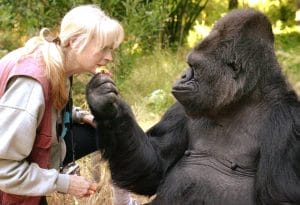Born on the Fourth of July, Hanabi-ko (Japanese for “Fireworks child”) was better known as Koko — a western lowland gorilla born at the San Francisco Zoo. While very young, the female gorilla was stricken with a serious illness, and put into the care of Francine “Penny” Patterson, who was studying for her doctorate in developmental psychology at Stanford University. Patterson taught Koko American Sign Language. Typically thought of as a language for the deaf, ASL is also often taught to children, who can use it to communicate before they can speak. Within two weeks, Koko could sign when she wanted food or drink — and her language abilities grew quickly from there. With the ability to communicate with Koko, Patterson found that gorillas could understand a lot more than humans ever thought they could. Koko eventually learned to use as many as 2,000 signs, and could understand about 2,000 more spoken English words. “She occasionally makes up new words [signs] which are amazingly appropriate, and she is able to string known words together in novel and meaningful constructions,” Patterson said early in her studies. “Koko also has a sense of humor and plays word games.”

Perhaps even more amazing, Koko asked for a present for Christmas in 1983: a kitten. She had learned of cats from children’s picture books, including Puss ’n’ Boots, and was given a toy stuffed cat — but Koko wasn’t satisfied with it, continually signing “sad.” So for her birthday in July, she was allowed to choose a kitten from an abandoned litter, and Koko named it “All Ball” — “Koko likes to rhyme words in sign language,” explained Gorilla Foundation biologist Ron Cohn. “The cat reacted to her as she would a human, but she was pretty independent and would bite Koko or wriggle loose when she got tired of being babied,” Cohn said. And when that happened, Koko would sign “Obnoxious cat.” All Ball was hit by a car and killed six months later. “When we told Koko, she acted like she didn’t hear us for about 10 minutes,” Cohn said at the time. “Then she started whimpering — a distinct hooting sound that gorillas make when they are sad. We all started crying together.” Then, Koko signed, “Sleep. Cat.” She later got other cats. A long term goal was for Koko to mate, to see if she would spontaneously teach her offspring sign language, but she didn’t seem interested in mating. Koko met a number of celebrities, and was particularly fond of Mr. Rogers, and Robin Williams (see video below). Koko lived longer than most gorillas, and died unexpectedly at the Gorilla Foundation’s preserve in California on June 19. She was 46.
Author’s Note: This experiment (and doing the research to write it up) inspired an episode of the Uncommon Sense podcast: What a Talking Ape Can Teach Humans. You don’t have to use a podcast app to listen (though that certainly works too): you can stream it directly from the Show Page (the link).
